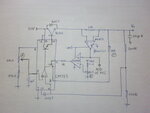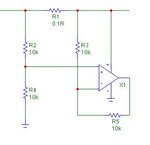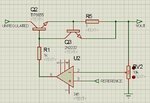gehan_s
Member level 3
dear all,
i am trying to make a voltage regulator using LM723. i understand the voltage regulation part. what i need is the current limiting. i have designed a opamp circuit to limit the current. it works as follows. i add a series 1ohm resistor to the load and measure the voltage difference across it. then i amplify the output (with a gain of 3.3) of it and give it to a comparator which compares it with a reference value set by me. if the output of the in-amp is larger than the set value it will turn on the internal current limiting transistor. i have connected the emitter of that transistor to the output of the power supply via a 10ohm resistor (C) to prevent the output shorting with the error amplifier.
opamp circuit to limit the current. it works as follows. i add a series 1ohm resistor to the load and measure the voltage difference across it. then i amplify the output (with a gain of 3.3) of it and give it to a comparator which compares it with a reference value set by me. if the output of the in-amp is larger than the set value it will turn on the internal current limiting transistor. i have connected the emitter of that transistor to the output of the power supply via a 10ohm resistor (C) to prevent the output shorting with the error amplifier.
the maximum current i'm hoping to take out is 1.5A with a Vout max of 28V. the reason i added the 3.3 gain is because i want it to be converted to a digital value for displaying purposes. hence at maximum current my in-amp will give about 4.9V.
my questions are,
1. will this opamp circuit work? (specially because i am trying to measure very small difference voltages and will the in-amp withstand these high voltages at its +,- terminals)
2. do i need the 10ohm resistor at pin 3 OR is there a better way to do it ????
3. can i connect the in-amp output straight away to pin 2 via a resistor ad get rid of the LM358
4. is there a better way to do all of these things?????
i have added a picture of my design herewith
thanks in advance
i am trying to make a voltage regulator using LM723. i understand the voltage regulation part. what i need is the current limiting. i have designed a
 opamp circuit to limit the current. it works as follows. i add a series 1ohm resistor to the load and measure the voltage difference across it. then i amplify the output (with a gain of 3.3) of it and give it to a comparator which compares it with a reference value set by me. if the output of the in-amp is larger than the set value it will turn on the internal current limiting transistor. i have connected the emitter of that transistor to the output of the power supply via a 10ohm resistor (C) to prevent the output shorting with the error amplifier.
opamp circuit to limit the current. it works as follows. i add a series 1ohm resistor to the load and measure the voltage difference across it. then i amplify the output (with a gain of 3.3) of it and give it to a comparator which compares it with a reference value set by me. if the output of the in-amp is larger than the set value it will turn on the internal current limiting transistor. i have connected the emitter of that transistor to the output of the power supply via a 10ohm resistor (C) to prevent the output shorting with the error amplifier.the maximum current i'm hoping to take out is 1.5A with a Vout max of 28V. the reason i added the 3.3 gain is because i want it to be converted to a digital value for displaying purposes. hence at maximum current my in-amp will give about 4.9V.
my questions are,
1. will this opamp circuit work? (specially because i am trying to measure very small difference voltages and will the in-amp withstand these high voltages at its +,- terminals)
2. do i need the 10ohm resistor at pin 3 OR is there a better way to do it ????
3. can i connect the in-amp output straight away to pin 2 via a resistor ad get rid of the LM358
4. is there a better way to do all of these things?????
i have added a picture of my design herewith
thanks in advance

